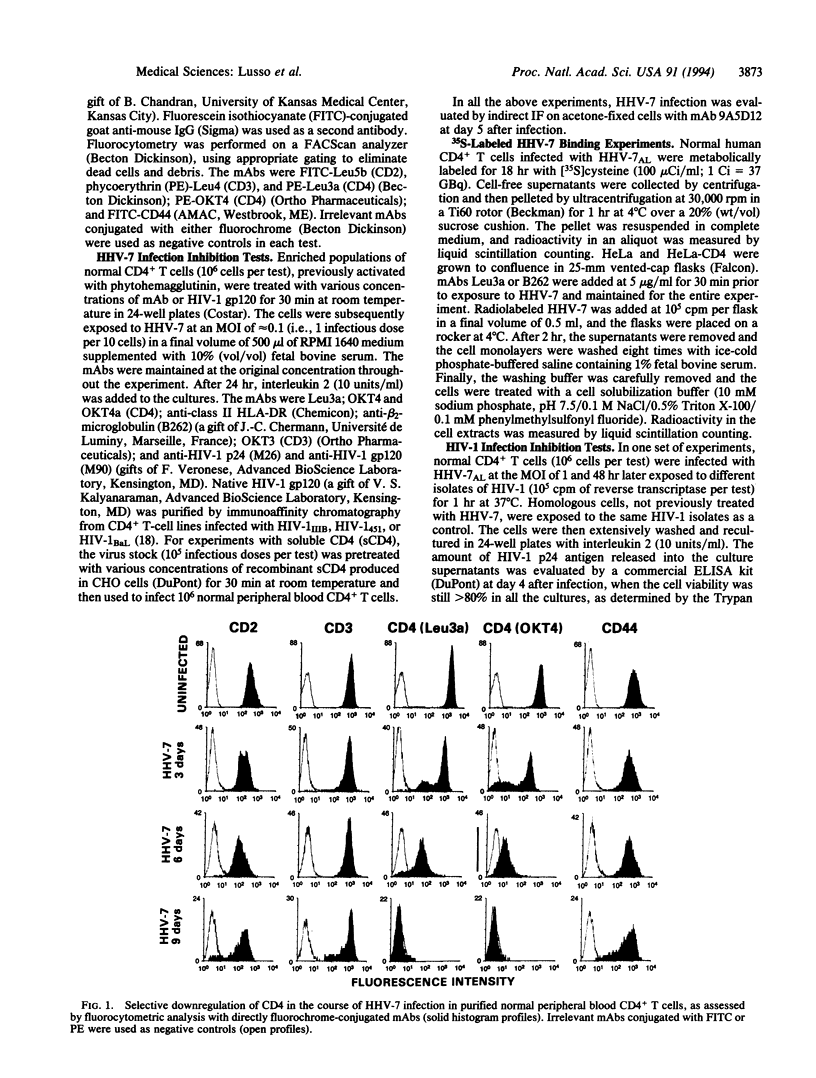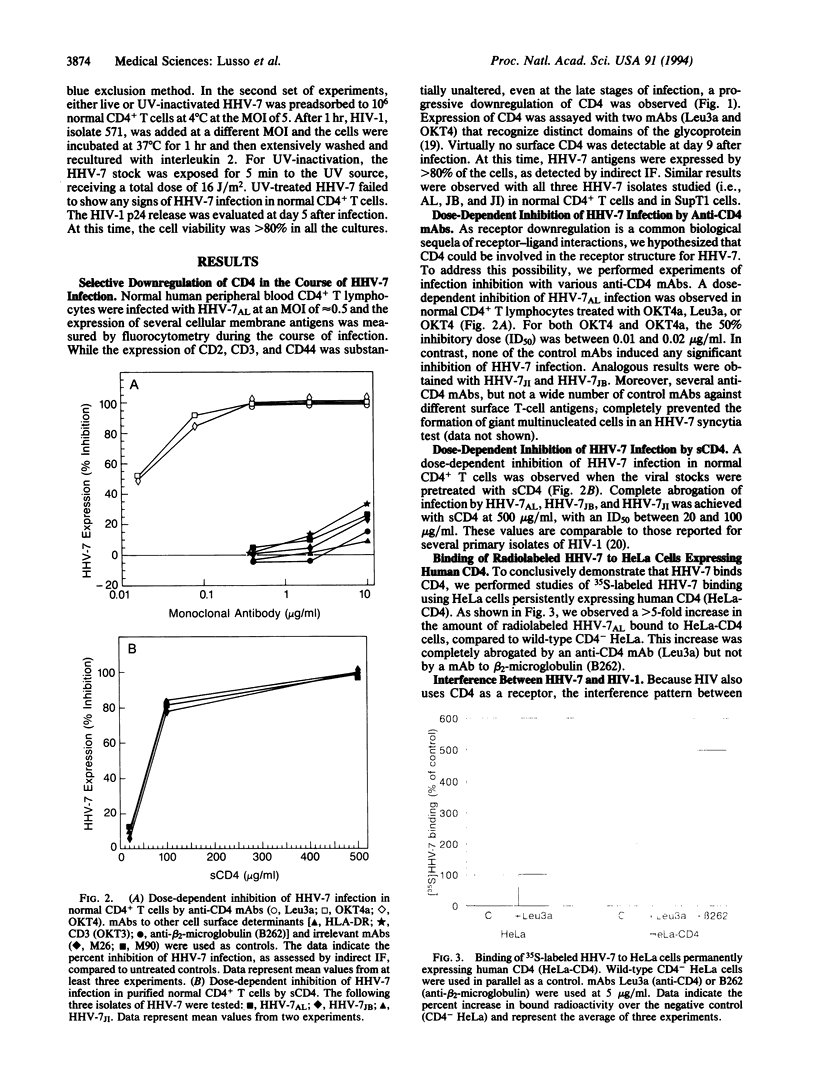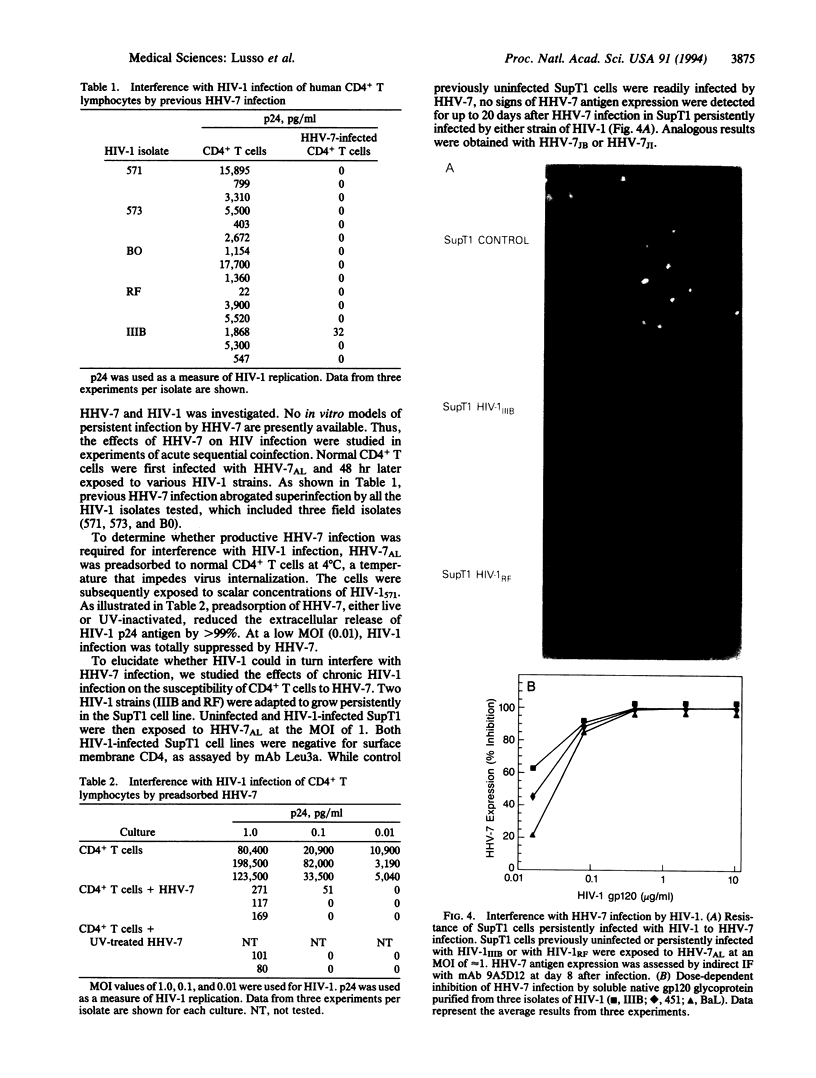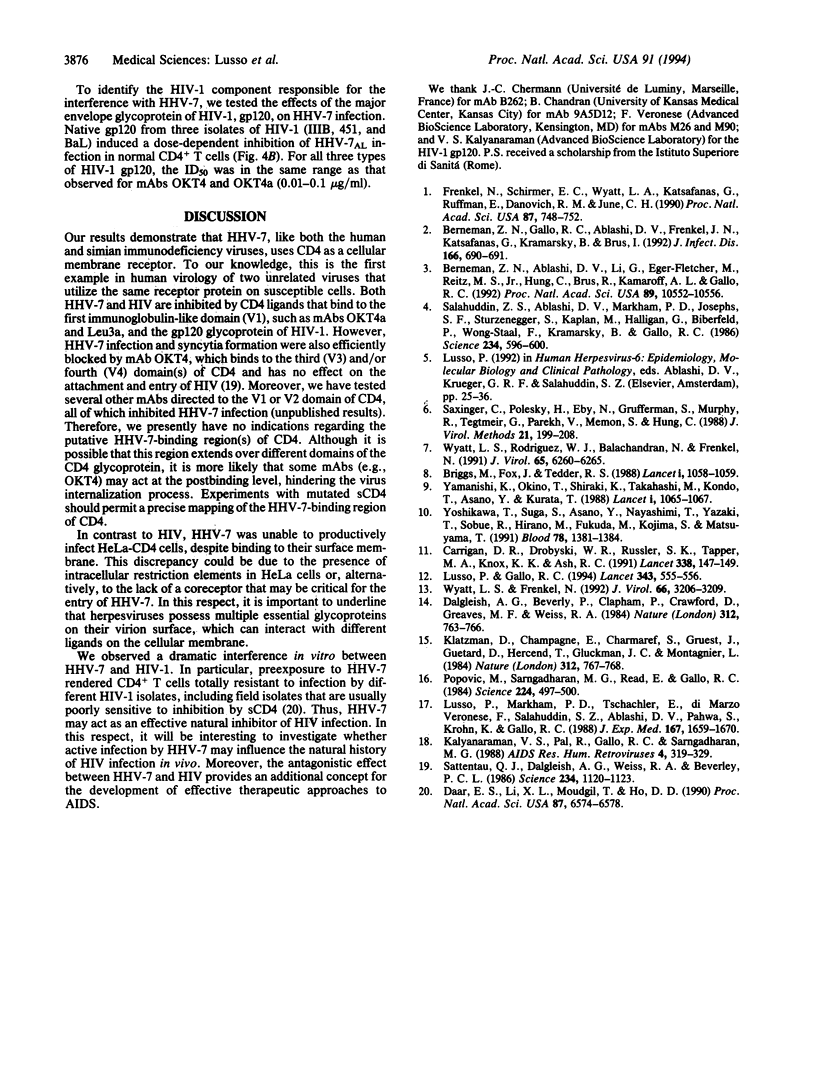Abstract
In this study, we demonstrate that the glycoprotein CD4, a member of the immunoglobulin superfamily, is a critical component of the receptor for human herpesvirus 7 (HHV-7), a recently discovered T-lymphotropic human herpesvirus. A selective and progressive downregulation of the surface membrane expression of CD4 was observed in human CD4+ T cells in the course of HHV-7 infection. Various murine monoclonal antibodies to CD4 and the recombinant soluble form of human CD4 caused a dose-dependent inhibition of HHV-7 infection in primary CD4+ T lymphocytes. Moreover, radiolabeled HHV-7 specifically bound to cervical carcinoma cells (HeLa) expressing human CD4. A marked carcinoma cells (HeLa) expressing human CD4. A marked reciprocal interference was observed between HHV-7 and human immunodeficiency virus (HIV), the retrovirus that causes the acquired immunodeficiency syndrome and also uses CD4 as a receptor. Previous exposure of CD4+ T cells to HHV-7 dramatically interfered with infection by both primary and in vitro-passaged HIV-1 isolates. Reciprocally, persistent infection with HIV-1 or treatment with the soluble form of gp120, the CD4-binding envelope glycoprotein of HIV-1, rendered CD4+ T cells resistant to HHV-7 infection. These data indicate that CD4 is critically involved in the receptor mechanism for HHV-7. The antagonistic effect between HHV-7 and HIV could be exploited to devise therapeutic approaches to AIDS.
Full text
PDF




Images in this article
Selected References
These references are in PubMed. This may not be the complete list of references from this article.
- Berneman Z. N., Ablashi D. V., Li G., Eger-Fletcher M., Reitz M. S., Jr, Hung C. L., Brus I., Komaroff A. L., Gallo R. C. Human herpesvirus 7 is a T-lymphotropic virus and is related to, but significantly different from, human herpesvirus 6 and human cytomegalovirus. Proc Natl Acad Sci U S A. 1992 Nov 1;89(21):10552–10556. doi: 10.1073/pnas.89.21.10552. [DOI] [PMC free article] [PubMed] [Google Scholar]
- Berneman Z. N., Gallo R. C., Ablashi D. V., Frenkel N., Katsafanas G., Kramarsky B., Brus I. Human herpesvirus 7 (HHV-7) strain JI: independent confirmation of HHV-7. J Infect Dis. 1992 Sep;166(3):690–691. doi: 10.1093/infdis/166.3.690. [DOI] [PubMed] [Google Scholar]
- Briggs M., Fox J., Tedder R. S. Age prevalence of antibody to human herpesvirus 6. Lancet. 1988 May 7;1(8593):1058–1059. doi: 10.1016/s0140-6736(88)91883-1. [DOI] [PubMed] [Google Scholar]
- Carrigan D. R., Drobyski W. R., Russler S. K., Tapper M. A., Knox K. K., Ash R. C. Interstitial pneumonitis associated with human herpesvirus-6 infection after marrow transplantation. Lancet. 1991 Jul 20;338(8760):147–149. doi: 10.1016/0140-6736(91)90137-e. [DOI] [PubMed] [Google Scholar]
- Daar E. S., Li X. L., Moudgil T., Ho D. D. High concentrations of recombinant soluble CD4 are required to neutralize primary human immunodeficiency virus type 1 isolates. Proc Natl Acad Sci U S A. 1990 Sep;87(17):6574–6578. doi: 10.1073/pnas.87.17.6574. [DOI] [PMC free article] [PubMed] [Google Scholar]
- Dalgleish A. G., Beverley P. C., Clapham P. R., Crawford D. H., Greaves M. F., Weiss R. A. The CD4 (T4) antigen is an essential component of the receptor for the AIDS retrovirus. Nature. 1984 Dec 20;312(5996):763–767. doi: 10.1038/312763a0. [DOI] [PubMed] [Google Scholar]
- Frenkel N., Schirmer E. C., Wyatt L. S., Katsafanas G., Roffman E., Danovich R. M., June C. H. Isolation of a new herpesvirus from human CD4+ T cells. Proc Natl Acad Sci U S A. 1990 Jan;87(2):748–752. doi: 10.1073/pnas.87.2.748. [DOI] [PMC free article] [PubMed] [Google Scholar]
- Kalyanaraman V. S., Pal R., Gallo R. C., Sarngadharan M. G. A unique human immunodeficiency virus culture secreting soluble gp160. AIDS Res Hum Retroviruses. 1988 Oct;4(5):319–329. doi: 10.1089/aid.1988.4.319. [DOI] [PubMed] [Google Scholar]
- Klatzmann D., Champagne E., Chamaret S., Gruest J., Guetard D., Hercend T., Gluckman J. C., Montagnier L. T-lymphocyte T4 molecule behaves as the receptor for human retrovirus LAV. Nature. 1984 Dec 20;312(5996):767–768. doi: 10.1038/312767a0. [DOI] [PubMed] [Google Scholar]
- Lusso P., Gallo R. C. Human herpesvirus 6 in AIDS. Lancet. 1994 Mar 5;343(8897):555–556. doi: 10.1016/s0140-6736(94)91515-6. [DOI] [PubMed] [Google Scholar]
- Lusso P., Markham P. D., Tschachler E., di Marzo Veronese F., Salahuddin S. Z., Ablashi D. V., Pahwa S., Krohn K., Gallo R. C. In vitro cellular tropism of human B-lymphotropic virus (human herpesvirus-6). J Exp Med. 1988 May 1;167(5):1659–1670. doi: 10.1084/jem.167.5.1659. [DOI] [PMC free article] [PubMed] [Google Scholar]
- Popovic M., Sarngadharan M. G., Read E., Gallo R. C. Detection, isolation, and continuous production of cytopathic retroviruses (HTLV-III) from patients with AIDS and pre-AIDS. Science. 1984 May 4;224(4648):497–500. doi: 10.1126/science.6200935. [DOI] [PubMed] [Google Scholar]
- Sattentau Q. J., Dalgleish A. G., Weiss R. A., Beverley P. C. Epitopes of the CD4 antigen and HIV infection. Science. 1986 Nov 28;234(4780):1120–1123. doi: 10.1126/science.2430333. [DOI] [PubMed] [Google Scholar]
- Saxinger C., Polesky H., Eby N., Grufferman S., Murphy R., Tegtmeir G., Parekh V., Memon S., Hung C. Antibody reactivity with HBLV (HHV-6) in U.S. populations. J Virol Methods. 1988 Sep;21(1-4):199–208. doi: 10.1016/0166-0934(88)90066-3. [DOI] [PubMed] [Google Scholar]
- Wyatt L. S., Frenkel N. Human herpesvirus 7 is a constitutive inhabitant of adult human saliva. J Virol. 1992 May;66(5):3206–3209. doi: 10.1128/jvi.66.5.3206-3209.1992. [DOI] [PMC free article] [PubMed] [Google Scholar]
- Wyatt L. S., Rodriguez W. J., Balachandran N., Frenkel N. Human herpesvirus 7: antigenic properties and prevalence in children and adults. J Virol. 1991 Nov;65(11):6260–6265. doi: 10.1128/jvi.65.11.6260-6265.1991. [DOI] [PMC free article] [PubMed] [Google Scholar]
- Yamanishi K., Okuno T., Shiraki K., Takahashi M., Kondo T., Asano Y., Kurata T. Identification of human herpesvirus-6 as a causal agent for exanthem subitum. Lancet. 1988 May 14;1(8594):1065–1067. doi: 10.1016/s0140-6736(88)91893-4. [DOI] [PubMed] [Google Scholar]
- Yoshikawa T., Suga S., Asano Y., Nakashima T., Yazaki T., Sobue R., Hirano M., Fukuda M., Kojima S., Matsuyama T. Human herpesvirus-6 infection in bone marrow transplantation. Blood. 1991 Sep 1;78(5):1381–1384. [PubMed] [Google Scholar]




